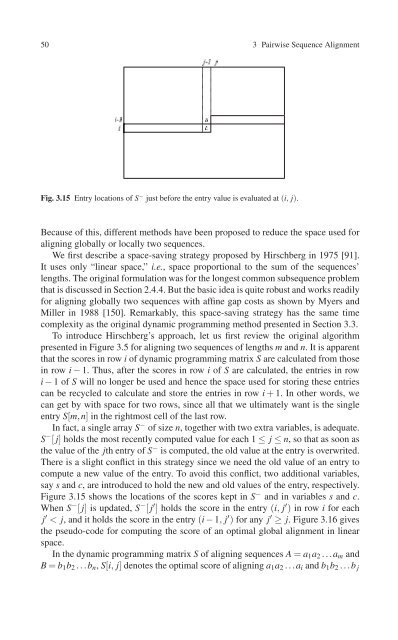Create successful ePaper yourself
Turn your PDF publications into a flip-book with our unique Google optimized e-Paper software.
50 3 Pairwise <strong>Sequence</strong> Alignment<br />
Fig. 3.15 Entry locations of S − just before the entry value is evaluated at (i, j).<br />
Because of this, different methods have been proposed to reduce the space used for<br />
aligning globally or locally two sequences.<br />
We first describe a space-saving strategy proposed by Hirschberg in 1975 [91].<br />
It uses only “linear space,” i.e., space proportional to the sum of the sequences’<br />
lengths. The original formulation was for the longest common subsequence problem<br />
that is discussed in Section 2.4.4. But the basic idea is quite robust and works readily<br />
for aligning globally two sequences with affine gap costs as shown by Myers and<br />
Miller in 1988 [150]. Remarkably, this space-saving strategy has the same time<br />
complexity as the original dynamic programming method presented in Section 3.3.<br />
To introduce Hirschberg’s approach, let us first review the original algorithm<br />
presented in Figure 3.5 for aligning two sequences of lengths m and n. It is apparent<br />
that the scores in row i of dynamic programming matrix S are calculated from those<br />
in row i − 1. Thus, after the scores in row i of S are calculated, the entries in row<br />
i − 1ofS will no longer be used and hence the space used for storing these entries<br />
can be recycled to calculate and store the entries in row i + 1. In other words, we<br />
can get by with space for two rows, since all that we ultimately want is the single<br />
entry S[m,n] in the rightmost cell of the last row.<br />
In fact, a single array S − of size n, together with two extra variables, is adequate.<br />
S − [ j] holds the most recently computed value for each 1 ≤ j ≤ n, so that as soon as<br />
the value of the jth entry of S − is computed, the old value at the entry is overwrited.<br />
There is a slight conflict in this strategy since we need the old value of an entry to<br />
compute a new value of the entry. To avoid this conflict, two additional variables,<br />
say s and c, are introduced to hold the new and old values of the entry, respectively.<br />
Figure 3.15 shows the locations of the scores kept in S − and in variables s and c.<br />
When S − [ j] is updated, S − [ j ′ ] holds the score in the entry (i, j ′ ) in row i for each<br />
j ′ < j, and it holds the score in the entry (i − 1, j ′ ) for any j ′ ≥ j. Figure 3.16 gives<br />
the pseudo-code for computing the score of an optimal global alignment in linear<br />
space.<br />
In the dynamic programming matrix S of aligning sequences A = a 1 a 2 ...a m and<br />
B = b 1 b 2 ...b n , S[i, j] denotes the optimal score of aligning a 1 a 2 ...a i and b 1 b 2 ...b j

















